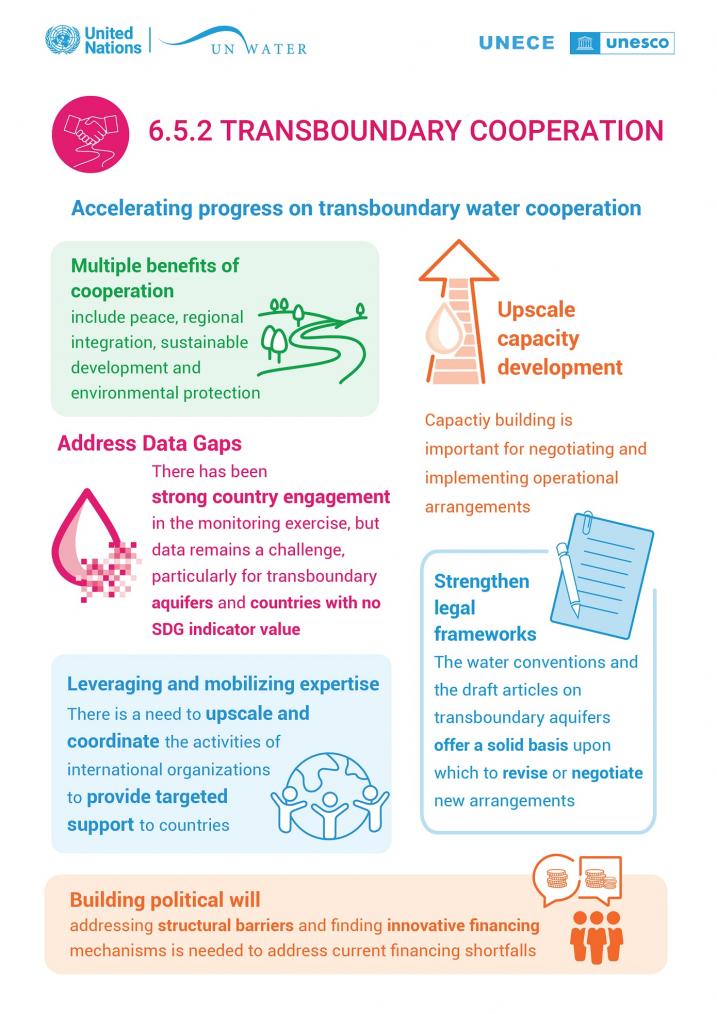During the second reporting exercise held in 2020/21, 129 out of 153 countries sharing transboundary waters responded to the invitation to report on SDG indicator 6.5.2. This increase in the response rate compared to the first reporting exercise represents an important milestone for further improvements in transboundary water cooperation on a global level. It shows that countries have responded positively to the second monitoring exercise and that reporting is viewed as an important tool for advancing water cooperation and sustainable development.
The review and analysis of the information submitted during the second reporting exercise was completed in 2021. The data transmitted through the national reports was the main source of information for the production of the joint UNECE-UNESCO second report on the Progress on Transboundary Water Cooperation: Global status of SDG indicator 6.5.2 and acceleration needs, 2021 on behalf of UN Water. Furthermore, the second reporting round informed global policy dialogues on the SDGs by allowing the co-custodian agencies to provide inputs to the Summary Progress Update 2021: SDG 6 – Water and Sanitation for All, the SDG 6 Data portal, the 2021 UN SDG Report and the UN Statistical Commission’s SDG indicators database.
Highlights and takeaways of the second reporting exercise on SDG indicator 6.5.2
Transboundary waters account for 60 per cent of the world’s freshwater flows and 153 countries have territory within at least one of the 286 transboundary river and lake basins and 592 transboundary aquifer systems. Cooperation over these waters offers multiple benefits and is an important contributor to many SDGs.
Over 80% of countries sharing transboundary basins (rivers, lakes and aquifers) submitted reports, compared with 70% in 2017. Despite the COVID-19 pandemic, this shows that countries have responded extremely positively to the second monitoring exercise, which in itself is a positive sign of country commitment to transboundary water cooperation at the global level. Greater engagement has improved data quality.
However, only 32 countries have 90 per cent or more of their transboundary basin area covered by operational arrangements, of which only 24 countries have all their basin area covered. Ensuring that operational arrangements cover all transboundary basins by 2030 will therefore require a significant acceleration in effort.
In line with the United Nations Decade of Action and the SDG 6 Global Acceleration Framework, efforts should focus on a number of key acceleration areas, including: addressing data gaps, upscaling capacity development, capitalizing on the global water conventions and draft articles on the law of transboundary aquifer, mobilizing political will, mainstreaming transboundary cooperation into national IWRM and other related sectoral actions, improving financing and leveraging and mobilizing expertise.

National country reports on SDG indicator 6.5.2 submitted for the 2nd reporting exercise are available here (https://unece.org/national-country-reports-sdg-indicator-652).
More information on the reporting process and the outcomes of the monitoring are available on the following webpages:
- Overview: Reporting on SDG indicator 6.5.2 and under the Water Convention
- Monitoring SDG indicator 6.5.2
- Reporting under the Water Convention
- First reporting exercise, 2017/18, on SDG indicator 6.5.2
- Second reporting exercise, 2020/21, on SDG indicator 6.5.2
- Third reporting exercise, 2023, on SDG indicator 6.5.2
- National country reports on SDG indicator 6.5.2
- Guidance materials and information for countries
- Workshops, events and meetings on reporting
- Reporting publications

